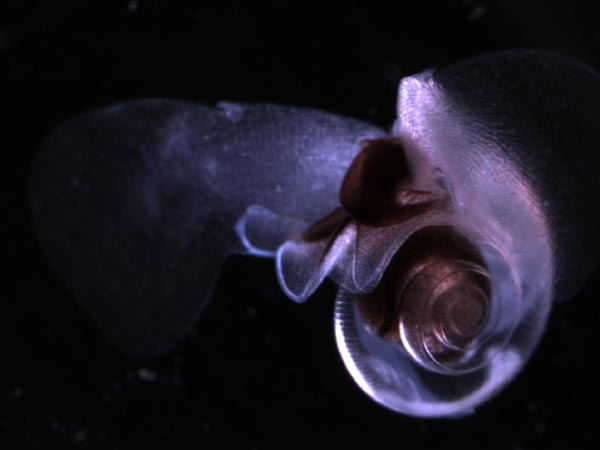Acidic seas spell bad news for sea butterflies
Thecosome pteropods, also known as sea butterflies, are an important group of ocean wanderers that may disappear from northern oceans by the end of century as the oceans become more acidic, removing a key food source for Arctic fish, birds and whales.
 One of the major threats facing the oceans is acidification - with increasing levels of carbon dioxide in the atmosphere, more of the gas is dissolving the oceans, leading to a lowering of pH and a reduction in the concentration of carbonate ions. And that's going to make life difficult for the many marine species that use these ions to build calcium carbonate shells, including sea butterflies.
One of the major threats facing the oceans is acidification - with increasing levels of carbon dioxide in the atmosphere, more of the gas is dissolving the oceans, leading to a lowering of pH and a reduction in the concentration of carbonate ions. And that's going to make life difficult for the many marine species that use these ions to build calcium carbonate shells, including sea butterflies.
They're closely related to the sea angels that featured in our Christmas show last year - you might remember the shelless molluscs that produce bad-tasting chemicals to defend themselves from attack. The main difference for the sea butterflies is that they protect themselves with a shell made from a relatively unstable form of calcium carbonate called aragonite.
Publishing in the Proceedings of the Royal Society B, the research team led by Steeve Comeau from the CNRS-INSU ocean laboratory in Villefranche-sur-Mer, in France, studied 2 sea butterflies - Limacina helicina from the Arctic, and Creseis acicula from the Mediterranean.
They combined lab studies of sea butterfly growth rates at different concentrations of carbonate ion with models of future changes in ocean chemistry based on projections from the IPCC (Intergovernmental Panel on Climate Change). And they found that in large parts of the Arctic, Limacina helicina will be unable to form shells by the end of the century.
Could Limacina live without a shell? Probably not. While some sea butterfly larvae do seem to be able to survive for some time without shells, Limacina would be left highly vulnerable to attack by predators and it would disrupt their buoyancy control - every day they undergo huge vertical migrations up and down the water column, it's thought to avoid the attention of predators during the day. And their shells are also important for keeping their soft body parts in place.
And if sea butterflies were to disappear from the Arctic, it could spell disaster because they play a vital role in the food web of pelagic ecosystems, forming the staple food source for many fish, birds and whales.
So, if these models play out, then this will be yet another major shift in ocean ecosystems, in a warmer, more acidic world.
- Previous Thermal camouflage
- Next How Earth got its gold





Comments
Add a comment